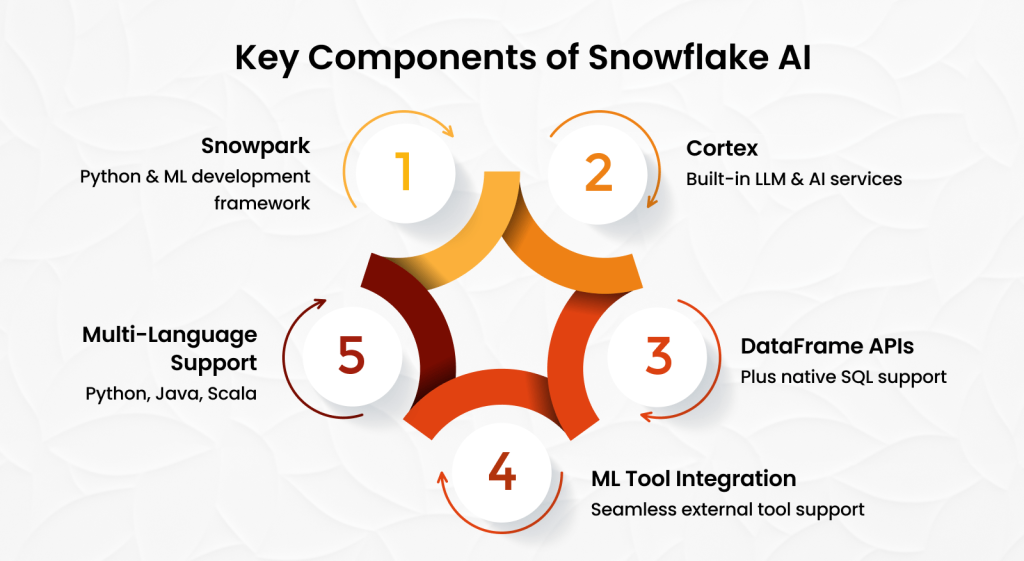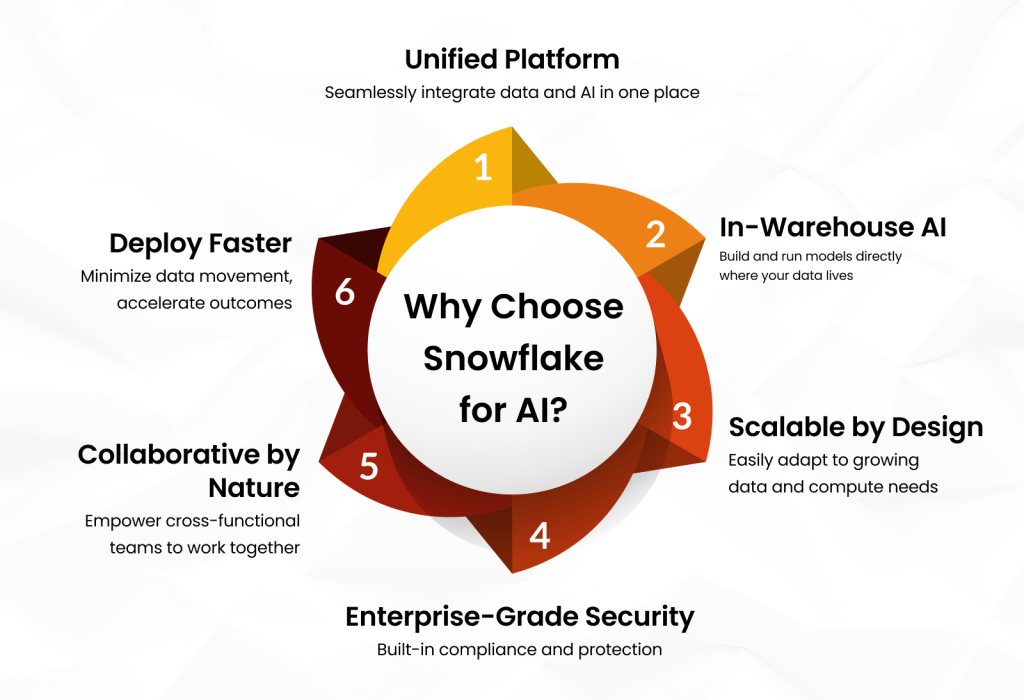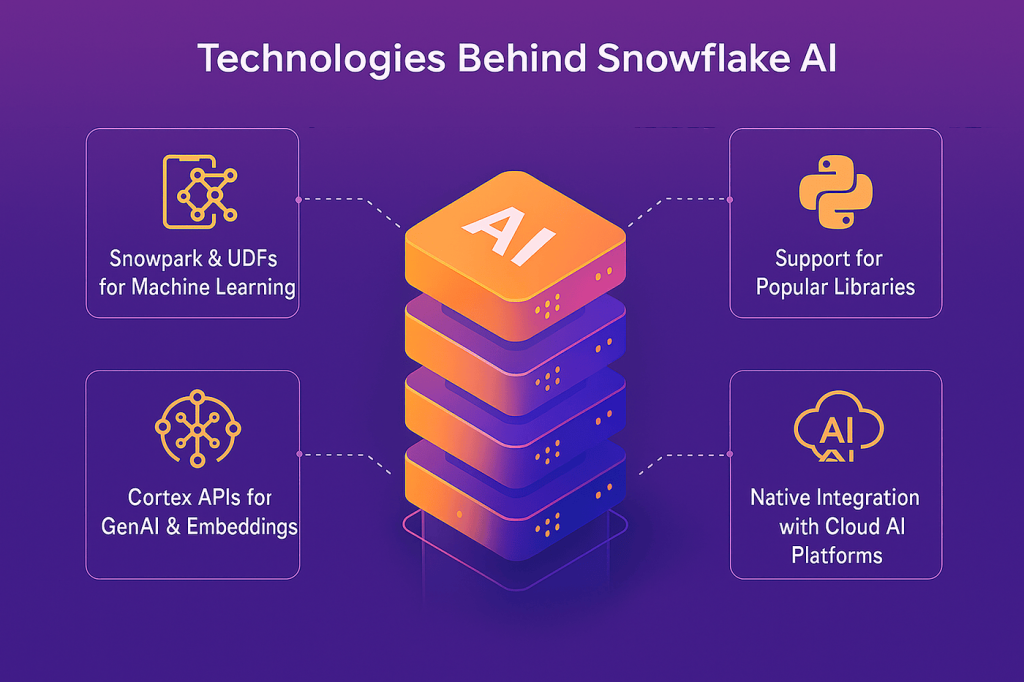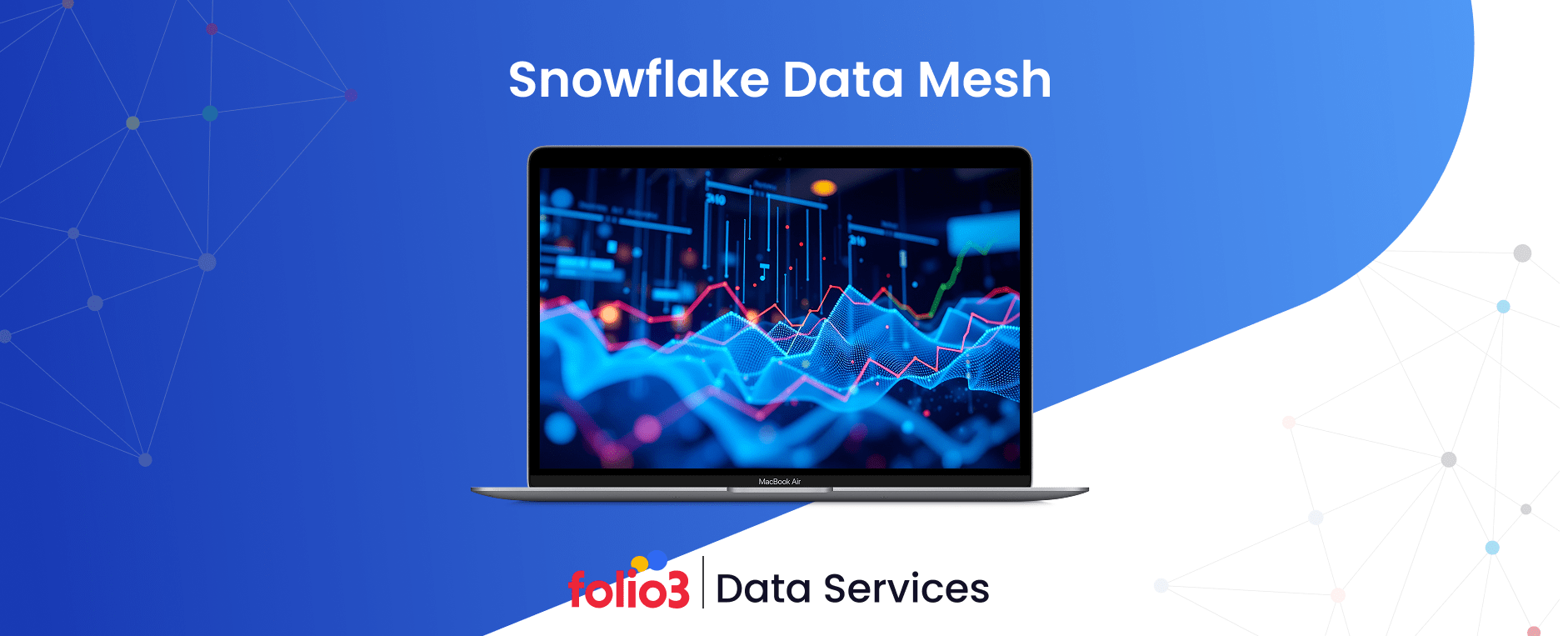Data continues to grow at an astonishing pace, with experts predicting the global data sphere will exceed 394 zettabytes by 2030, according to projections from IDC. This rapid expansion is driving the need for smarter ways to manage and analyze information.
Snowflake AI is emerging as a game changer by bridging the gap between traditional data warehousing and artificial intelligence, enabling businesses to unlock valuable insights more easily. Unlike conventional systems that separate data storage and machine learning processes, Snowflake AI integrates these capabilities within a single platform.
This integration enables data scientists and analysts to apply machine learning (ML) models directly to live data, eliminating the need for data movement. With features like Snowflake ML-powered functions, organizations can accelerate predictive analytics and data-driven decision-making. For anyone curious about how Snowflake artificial intelligence reshapes data analytics or explores Snowflake for machine learning, understanding this innovation is crucial.
This blog will explore the essentials of Snowflake AI and its role in the convergence of modern data and AI, offering a clear picture without overwhelming technical jargon. So, let’s get started!
What is Snowflake AI?
At its core, Snowflake AI refers to the set of artificial intelligence and machine learning capabilities built directly into the Snowflake data platform. Traditionally, data warehousing and AI tools have operated separately, with data first being stored, then extracted and moved to different systems for AI and machine learning tasks. Snowflake AI changes this by combining these steps into one environment.
This means users can run machine learning models right where their data lives, without the need for complex data transfers or external infrastructure. Snowflake AI includes tools such as Snowflake ML-powered functions, which enable data teams to create, train, and deploy machine learning models directly within Snowflake. This unified approach streamlines processes, allowing businesses to gain faster insights from their data.
By embedding AI directly into its cloud data platform, Snowflake provides an accessible way for organizations, whether they are data scientists, analysts, or business users, to use the power of Snowflake artificial intelligence without needing deep technical expertise in AI or complex software setups.
Key Components of Snowflake AI
Snowflake AI is more than just a concept. It’s a collection of powerful tools and capabilities that work together to bring AI and machine learning directly into the Snowflake platform. Understanding key Snowflake features—such as native support for machine learning, seamless data sharing, and scalable computing—helps clarify how Snowflake makes AI accessible and practical for modern data needs.

Snowpark for Python and ML Development
Snowpark is Snowflake’s developer framework that supports Python and other languages, such as Java and Scala. It allows data engineers and data scientists to build, train, and run machine learning models directly within Snowflake. With Snowpark for Python, users can write ML code close to the data, eliminating the delays and risks associated with moving data between different systems.
Snowflake Cortex for Built-In LLM and AI Services
Snowflake Cortex is the platform’s built-in solution for large language models (LLMs) and AI services. It enables users to deploy and manage advanced AI models, such as those used in natural language processing and data analysis, without requiring external AI infrastructure. This component brings sophisticated AI tools into the Snowflake environment, making advanced analytics more accessible.
DataFrame APIs and Native SQL Support
Snowflake supports DataFrame APIs, which provide a familiar way for developers to manipulate data programmatically, in addition to native SQL support. This combination enables users to easily integrate Snowflake AI analytics into existing SQL queries, blending traditional analytics with machine learning-powered insights.
Integration with External ML Tools
Recognizing that many organizations utilize specialized AI platforms, Snowflake integrates seamlessly with popular external machine learning tools, including DataRobot and Hugging Face. Through robust Snowflake data integration, teams can use their preferred AI frameworks while still relying on Snowflake’s platform for centralized storage and high-performance processing—combining flexibility with efficiency.
Support for Python, Java, and Scala in the Snowflake Environment
Beyond Python, Snowflake allows development in Java and Scala within its environment. This multi-language support means data teams can use the programming languages they’re most comfortable with to build and deploy AI models, all while keeping data centralized and secure in Snowflake.
Practical AI Use Cases Supported by Snowflake
Snowflake artificial intelligence isn’t just theoretical, but it powers real-world applications across industries, helping organizations turn their data into actionable insights. Here are some common ways businesses are using Snowflake’s AI capabilities:

Predictive Analytics and Forecasting
By applying machine learning models directly within Snowflake, companies can forecast sales, inventory needs, and market trends with greater accuracy. This enables teams to plan with confidence, informed by data-driven predictions. Many organizations accelerate these outcomes by partnering with Snowflake consulting services to optimize model deployment and performance.
Natural Language Processing (NLP)
Snowflake supports NLP tasks, such as text summarization and sentiment analysis, enabling businesses to analyze customer feedback, social media data, and other unstructured text to understand public opinion better and improve their services.
Anomaly Detection in Operational and Financial Data
Snowflake AI can identify unusual patterns or outliers in data streams, such as fraudulent transactions or system failures, enabling organizations to respond quickly before minor issues escalate into major problems.
Recommendation Systems
Retailers and content platforms utilize Snowflake’s ML-powered functions to develop recommendation engines that suggest products, articles, or services tailored to individual user preferences, thereby enhancing customer experience and engagement. Efficient Snowflake data ingestion ensures these systems have access to the freshest and most comprehensive customer data for accurate recommendations.
Churn and Customer Behavior Modeling
By analyzing historical customer data within Snowflake, businesses can identify which customers are likely to leave and develop targeted strategies to retain them, ultimately enhancing loyalty and revenue.
Data Enrichment and Classification Tasks
Snowflake AI helps automate the process of categorizing and tagging large datasets, making it easier for companies to organize and utilize their data for reporting, compliance, and decision-making.
Make your Snowflake AI initiatives faster, smarter, and more impactful with Folio3’s expert data integration and optimization services.
Benefits of Using Snowflake for AI
Snowflake has quickly become a preferred platform for organizations seeking to consolidate data storage, analytics, and artificial intelligence in a single location. Here’s why Snowflake stands out when it comes to supporting AI and machine learning initiatives:

A Single Platform That Brings Data and AI Together
One of Snowflake’s biggest strengths is its ability to unify data management and AI workflows within a single platform. Instead of juggling multiple systems for data storage, processing, and machine learning, Snowflake lets you handle everything in one place. This reduces complexity, lowers costs, and speeds up project timelines by eliminating the need to move data between separate environments constantly.
Build and Run AI Models Directly Inside Your Data Warehouse
Snowflake enables in-database model development and inference, allowing data scientists to create, train, and deploy machine learning models directly within the Snowflake data warehouse. This removes traditional barriers, like exporting data to external ML tools, which can introduce delays, security risks, and data inconsistencies. Real-time access to fresh data enables the production of more accurate models and faster insights.
Flexible, Scalable Infrastructure That Grows With Your Needs
Handling large volumes of data and complex AI computations requires a robust infrastructure. Snowflake’s architecture, built on a cloud-native foundation, provides scalable compute and storage that automatically adjusts to meet demand. Whether you’re running small experiments or large-scale AI applications, Snowflake can scale up or down without any disruption, giving your teams the resources they need without overpaying.
Security and Compliance Built for Enterprise
Data privacy and regulatory compliance are top concerns in AI projects. Snowflake offers robust security features—including data encryption, role-based access controls, and comprehensive auditing—that enable organizations to meet industry standards such as GDPR and HIPAA. This gives businesses confidence that their data and AI models are protected from unauthorized access.
Easier Collaboration Across Diverse Teams
AI projects often involve multiple roles, from data engineers and scientists to analysts and business users. Snowflake’s platform enables simplified collaboration by providing shared access to data and tools, eliminating the need for complicated handoffs. Teams can even pair these capabilities with AI enterprise search to quickly locate the most relevant datasets, documentation, or model outputs, ensuring everyone works from the same trusted data source and reducing errors.
Faster Deployment with Less Data Movement
Traditionally, moving data back and forth between warehouses and AI tools adds time and risk. Snowflake minimizes this by allowing seamless deployment of AI models within the platform, reducing the need for data transfers. This means quicker results and fewer chances for data to become outdated or compromised during movement.
Technologies Powering AI Capabilities in Snowflake
Snowflake’s AI offerings rely on a combination of advanced technologies that allow users to build, deploy, and scale machine learning and AI applications with ease. These technologies create a flexible environment suited for both beginners and experienced data professionals.

Snowpark and User-Defined Functions (UDFs) for Machine Learning
Snowpark is Snowflake’s developer framework designed to run custom code close to the data. It supports multiple languages, including Python, Java, and Scala. Using Snowpark, data teams can create user-defined functions (UDFs) to embed machine learning models directly within Snowflake’s platform. This approach keeps data in place, allowing models to be trained and executed without requiring extra data movement, thereby improving speed and security. For use cases like Snowflake audience management, this means faster segmentation, real-time personalization, and more secure activation of insights without moving data outside the platform.
Cortex APIs for Generative AI and Embeddings
Snowflake Cortex provides APIs specifically designed for generative AI tasks, including text generation and advanced data embeddings. These services enable users to integrate large language models (LLMs) and other AI-driven capabilities into their data workflows. By accessing Cortex APIs, organizations can enhance applications with natural language understanding, summarization, and other AI-powered features directly inside Snowflake.
Support for Popular Python Libraries
Python is the language of choice for many data scientists, and Snowflake supports key Python libraries like pandas (for data manipulation), scikit-learn (for machine learning), and xgboost (for gradient boosting). This native compatibility allows users to apply familiar tools and algorithms within Snowflake’s environment, simplifying development and enabling faster experimentation.
Native Integration with Major Cloud AI Ecosystems
Recognizing that many organizations use cloud-based AI platforms, Snowflake integrates smoothly with services such as AWS SageMaker and Azure Machine Learning. This enables teams to connect Snowflake’s data platform with external AI tools, extending their capabilities and using specialized infrastructure while maintaining centralized data management.
Snowflake Use Cases Across Industries
Snowflake artificial intelligence is revolutionizing operations across various sectors by unifying data, analytics, and machine learning on a single platform. Organizations can pair these capabilities with AI data extraction solutions to automatically ingest and structure information from diverse sources, enabling richer analytics and faster insights without adding complexity to their workflows.
Finance: Fraud Detection and Risk Modeling – Intercontinental Exchange (ICE)
Intercontinental Exchange (ICE), operator of the New York Stock Exchange (NYSE), uses Snowflake to enhance regulatory compliance and manage complex, high-volume data with ease. By using Snowpark, ICE cut data costs for NYSE’s regulatory reporting by over 50% while boosting ad hoc query performance by 80%.
Snowflake’s near-infinite scalability and cost transparency enable ICE to process billions of time-sensitive financial transactions efficiently, reducing operational complexity and increasing analytics throughput. Leveraging Snowflake data analytics, ICE can focus more on fraud detection, risk modeling, and innovation, turning massive data workloads into actionable financial intelligence.
Healthcare: Patient Outcome Prediction and Claims Automation – AMN Healthcare
Healthcare organizations use Snowflake to centralize diverse data sources, predict patient outcomes using AI/ML, and automate claims processing for operational efficiency. AMN Healthcare, a leading healthcare staffing provider, adopted Snowflake to eliminate data silos, reduce pipeline complexity, and enhance operational decision-making.
By integrating Snowflake with Azure Data Factory and Microsoft Power BI, AMN:
- Reduced data lake costs by 93%, saving $2.2 million annually while storing 50% more data.
- Achieved a 99.9% pipeline success rate, drastically improving system reliability.
- Enabled real-time and ad hoc reporting across departments, boosting visibility into staffing performance, placement metrics, and client outcomes.
- Used Snowflake’s multi-cluster shared architecture and per-second pricing to lower costs and support dynamic analytics needs.
- Plans to expand its Snowflake usage into AI/ML initiatives using Snowpark, enhancing predictive modeling, and further improving patient care strategies.
Manufacturing: Predictive maintenance and yield optimization – Honeywell
Honeywell, a global manufacturing giant with over 100 years of history, transitioned from managing 33 separate enterprise data warehouses to a single unified Snowflake AI Data Cloud.
Leveraging Snowflake data modernization services, this consolidation created a reliable, single source of truth, enabling Honeywell to gain actionable insights across its complex operations. By integrating all its data within Snowflake, Honeywell significantly enhanced its ability to manage a vast supply chain involving millions of SKUs and thousands of suppliers.
Near real-time data analytics enables Honeywell to optimize inventory management, better match supply with demand, and respond swiftly to industry challenges such as supply chain disruptions and inflation. Additionally, Snowflake supports Honeywell’s sustainability mission, with 60% of its portfolio now focused on sustainable products.
Retail: Personalized Product Recommendations and Demand Forecasting – PETCO
Petco utilizes Snowflake to deliver hyper-personalized shopping experiences, driving revenue growth and operational efficiency. By consolidating data from over 1,500 stores and millions of online interactions, Petco built a 360-degree view of its customers.
Snowflake’s platform enables real-time analytics, powering tailored product recommendations, dynamic promotions, and more innovative pricing strategies by region and behavior. The results speak for themselves: 50% faster data processing, a 20% increase in data science team productivity, and measurable gains through Snowflake cost optimization strategies.
Snowflake’s built-in visibility tools also help Petco manage workloads and forecast demand more accurately, leading to smarter decisions across marketing, supply chain, and merchandising.
Marketing: Customer Segmentation and Sentiment Analysis – Warner Music Group (WMG)
Warner Music Group uses Snowflake to power its data-driven marketing efforts by centralizing billions of rows of fan interaction data into a single, scalable platform. By integrating Snowflake with Hightouch, WMG rapidly syndicates hundreds of targeted audience segments across channels without relying on third-party CDPs.
This enables marketers and artist teams to deliver highly personalized fan experiences, optimize multi-channel campaigns, and accelerate time-to-insight. Snowflake’s secure data sharing also fosters collaboration across departments, fueling innovation and operational efficiency. WMG continues to expand its use of Snowflake for more in-depth segmentation and enhanced fan engagement.
Folio3 helps enterprises tailor Snowflake’s AI and analytics to their industry needs — optimizing performance, cutting costs, and accelerating insights.
Best Practices for Using Snowflake AI Effectively
Getting the most out of Snowflake AI means more than just having the right tools; it requires innovative strategies to ensure your AI projects deliver accurate, timely, and reliable results. Here are some best practices to guide your AI initiatives on Snowflake:
Keep AI Workloads Close to the Data
One of Snowflake’s key advantages is enabling AI computations directly where your data lives. Designing your AI workloads to run within Snowflake reduces latency and avoids the delays and risks associated with transferring data between systems. This approach accelerates model training and prediction, enabling the delivery of more timely and actionable insights.
Use Version Control and Reproducible Environments
Maintaining consistency is critical in AI projects. Tools like Anaconda can be used within Snowpark to create reproducible environments, ensuring that your machine learning experiments can be repeated and verified. Version control helps track changes in code and models, supporting collaboration and reducing errors—key aspects of effective Snowflake data engineering.
Prioritize Data Governance and Model Monitoring
AI models are only as good as the data they use. Establish clear governance policies to manage data quality, privacy, and security. Additionally, monitor model performance regularly to detect any degradation or bias that may occur over time. Snowflake’s built-in security features and audit capabilities make it easier to maintain control over your AI workflows.
Build Modular, Reusable Pipelines
Creating modular AI pipelines, where components such as data preprocessing, model training, and evaluation are separated, allows for greater flexibility and scalability. This way, you can update or swap individual parts without rebuilding entire workflows, saving time and resources as your projects evolve.
Use Snowflake Marketplace for Third-Party Models and Data
Snowflake Marketplace offers a growing collection of third-party machine learning models and datasets that you can integrate directly into your AI workflows. This resource helps accelerate development by providing pre-built models and rich data sources, so you don’t always have to start from scratch.
How Folio3 Data Helps You Implement Snowflake AI?
Adopting Snowflake AI analytics is a significant step toward modernizing your data and analytics infrastructure. But without the right expertise, the transition can feel overwhelming. That’s where Folio3 Data comes in, offering end-to-end Snowflake implementation and AI integration services tailored to your business goals.
Full-Cycle Implementation from Planning to Optimization
Whether you’re starting fresh or migrating from an existing data warehouse, Folio3 Data handles the complete Snowflake setup. Their Snowflake migration services include a readiness assessment, proof of concept (POC), data integration planning, and full-scale deployment. From connecting your CRM and ERP systems to designing your warehouse architecture, every step is carefully planned to ensure scalability and long-term performance.
Deep Expertise in Snowpark and Cortex AI Services
Folio3’s Data team of certified Snowflake professionals brings hands-on experience with Snowpark, enabling the creation of custom machine learning workflows using Python, Java, or Scala. As part of their Snowflake implementation services, they also support deployments that leverage Snowflake Cortex APIs—helping you build solutions that incorporate generative AI, natural language processing, and advanced analytics natively within your data platform.
Smooth Integration with External AI and ML Ecosystems
Do you need to integrate your Snowflake environment with external tools such as AWS SageMaker, Azure ML, DataRobot, or Hugging Face? Folio3 Data ensures smooth interoperability across platforms. This means you can continue using your preferred AI and ML tools while centralizing your data in Snowflake, without the hassle of excessive data movement or format conversion.
Security-First Approach with Compliance Built In
Snowflake AI implementations demand strong governance. Folio3 Data ensures your environment is compliant with security protocols, audit requirements, and data protection standards. Our data engineering services help establish access controls, data masking, encryption policies, and compliance frameworks that meet industry and regulatory needs.
Knowledge Transfer and Long-Term Support
Folio3 Data doesn’t just implement and disappear. Post-deployment, they offer performance tuning, monitoring, ETL/ELT optimization, and ongoing maintenance. To future-proof your investment, Folio3 Data also provides hands-on training and enablement sessions, enabling your internal teams to scale and innovate confidently using Snowflake AI.
Snowflake AI – Summary
Snowflake AI combines cloud data warehousing and machine learning into a single platform, enabling businesses to run ML models directly on live data. With Snowpark, Cortex, and seamless integration with external AI tools, Snowflake accelerates predictive analytics, NLP, anomaly detection, and personalization.
FAQs
Can I train machine learning models directly in Snowflake?
Yes, Snowflake allows in-database model training using Snowpark and supported languages like Python. This eliminates the need for data movement and simplifies ML workflows.
How is Snowflake AI different from traditional AI/ML platforms?
Snowflake AI combines data storage, processing, and machine learning (ML) in one unified platform. Unlike traditional setups, it reduces complexity by keeping data and AI workloads tightly integrated.
How secure is it to run AI workloads on Snowflake?
Snowflake provides enterprise-grade security, featuring built-in encryption, role-based access controls, and compliance certifications. Your AI workloads run in a controlled, governed environment.
What are the top use cases for AI and Machine Learning on Snowflake’s platform?
Snowflake powers AI and machine learning for predictive analytics, fraud detection, customer personalization, data sharing, and MLOps, unifying data to simplify model development and deployment with strong governance and cost efficiency.
Is it possible to use Snowflake for natural language processing tasks?
Yes, Snowflake can support natural language processing by storing and managing large text datasets, enabling feature extraction with Snowpark or SQL, and integrating with external NLP libraries or services for model training and deployment.
Which AI-native personalization platforms integrate smoothly with segment and Snowflake?
AI-native personalization platforms that integrate smoothly with Segment and Snowflake include Amplitude, Braze, Iterable, Optimizely, Dynamic Yield, and Salesforce Marketing Cloud. These tools connect Segment’s customer data with Snowflake’s cloud warehouse to deliver real-time personalization and predictive insights.
How does Snowflake scale to handle heavy AI computational tasks?
Snowflake handles heavy AI tasks by separating storage and compute, letting you scale virtual warehouses on demand for parallel processing of large datasets with consistent performance and cost control.
How to use Snowflake for model explainability or bias detection in AI projects?
Use Snowflake to store training data, model outputs, and metrics, then run SQL or Snowpark queries to analyze feature impacts, compare predictions, and share datasets with explainability or bias detection tools for transparent, auditable AI projects.
How effective is Snowflake for training ML models on large-scale datasets?
Snowflake effectively trains ML models on large datasets by unifying data, enabling fast feature engineering, and integrating with external ML frameworks for scalable training and deployment.
How can social media companies use Snowflake for sentiment analysis and insights?
Social media companies can use Snowflake to centralize massive text and engagement data, run sentiment analysis with SQL or Snowpark, and integrate external NLP tools to deliver real-time audience insights and trend detection.
Conclusion
Snowflake’s transformative impact across industries from healthcare to manufacturing highlights the power of unified, scalable data platforms in driving operational efficiency, cost savings, and more intelligent decision-making. Companies like AMN Healthcare and Honeywell demonstrate how Snowflake enables real-time insights, streamlined data management, and advanced analytics.
To fully use these benefits, Folio3 offers expert Snowflake consulting, data engineering, and AI-driven analytics services designed to optimize your data ecosystem and accelerate your digital transformation journey.
Partner with Folio3 to unlock the full potential of your data!



